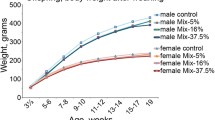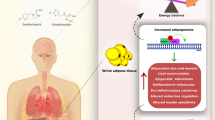Abstract
Some pesticides increase the risk of type 2 diabetes, but whether fetal exposure carries transgenerational risk remains unknown. We evaluated the metabolic effects of gestational exposure to chlorpyrifos and imidacloprid in female Wistar rats and their offspring. We studied female nulliparous Wistar rats, including six exposed to imidacloprid (IMI) and six to chlorpyrifos (CPF) once daily throughout gestation at 1/10 lethal dose 50, while six (control group) received distilled water. These were explored 1 month after the birth of the offspring, while their offspring were explored at weaning (4 weeks) and adult age (12 weeks). Blood glucose, insulin and lipid profile were determined at each stage, while glucose transporter 4 (GLUT4) and nuclear factor kappa beta (NFkβ) protein expression was measured in skeletal muscle at the end of follow up. Exposure to pesticides was associated with significantly higher fasting glucose (+25.4 to 30.9%) and insulin (> 100%) levels, with > 100% increased insulin resistance (HOMA-IR), − 18.3 to − 21.1% reduced HDL-cholesterol and + 60.9 to + 102.6% increased LDL-cholesterol in mothers. GLUT4 expression was reduced by 28.9–42.3% while NFkβ expression increased by 32.8–35.4% in mothers. In offspring, similar abnormalities were observed at weaning (+ 18.4 to 67.4% fasting glucose, + 57.1 to 72.2% LDL-cholesterol, + 72.3 to 78.2% fasting insulin), persisting at adult age with decreased expression of GLUT4 (− 52.8 to 54.5%) and increased expression of NFkβ (+ 30.5 to 30.7%). Gestational exposure to imidacloprid and chlorpyrifos induces hyperglycemia, insulin resistance and dyslipidemia in female Wistar rats and their offspring. The effects on offspring persist until adult age, suggesting intergenerational adverse effects.






Similar content being viewed by others
Abbreviations
- ACh:
-
Acetylcholine
- ANOVA:
-
Analysis of variance
- CPF:
-
Chloropyrifos
- EDTA:
-
Ethylene diamine tetra-acetic acid
- ELISA:
-
Enzyme-linked immuno-sorbent assay
- EC:
-
Emulsifiable concentrate
- FBG:
-
Fasting blood glucose
- GLUT4:
-
Glucose transporter-4
- HDL:
-
High density lipoprotein
- HOMA-IR:
-
Homeostasis model assessment of insulin resistance
- HOMA-β:
-
Homeostasis model assessment of beta cell function
- ICGEB:
-
International Center for Genetic Engineering and Biotechnology
- IMI:
-
Imidacloprid
- LDL:
-
Low density lipoprotein
- NFkβ:
-
Nuclear factor kappa beta
- PBST:
-
Phosphate buffered saline tween
- SEM:
-
Standard error of mean
- TC:
-
Total cholesterol
References
Food and Agricultural Organization of the United Nations: International Code of Conduct on distribution and use of pesticide (2002). Retrieved on 25 Oct 2007
Ngwa EN, Kengne AP, Atogho BT, Mofo-Mato EP, Sobngwi E (2015) Persistent organic pollutants as risk factors for type 2 diabetes. Diabetol Metab Syndr 7:41. https://doi.org/10.1186/s13098-015-0031-6
Swackhamer D, Hites RA (1988) Occurrence and bioaccumulation of organochlorine compounds in fish from Siskiwit Lake, Isle Royale, Lake Superior. Environ Sci Technol 22:543–548
Jeschke P, Nauen R, Schindler M, Elbert A (2011) Overview of the status and global strategy for neonicotinoids. J Agric Food Chem 59:2897–2908
Rekha R, Sunanda R, Sajad H (2013) Histopathological effects of pesticide-cholopyrifos on kidney in albino rats. Int J Res Med Sci 1:465–475
Nagata K, Song JH, Shono T, Narahashi T (1998) Modulation of the neuronal nicotinic acetylcholine receptor-channel by the nitromethylene heterocycle imidacloprid. J Pharmacol Exp Ther 285:731–738
Tinoco R, Halperine D (1998) Poverty production and health: inhibition of erythrocyte cholinesterase via occupational exposure to organophosphate insecticides in Chipas, Mexico. Arch Environ Health 53:29–35
Ahmed MM, Zaki NI (2009) Assessment of the ameliorative effects of pomegranate and rutin on chloropyrifos-ethyl-induced oxidative stress in rats. Nat Sci 7:49–61
Bas H, Kalender Y (2011) Chloropyrifos-induced cardiotoxicity in rats and the protective role of Quercetin and Catechin. Gazi Univ J Sci 24:387–395
El-Gendy KS, Aly NM, Mahmood FH, Kenawy A, El-Sebae AK (2010) The role of Vitamin C as antioxidant in protection of oxidative stress induced by imidacloprid. Food Chem Toxicol 48:215–221
Ndonwi EN, Atogho BT, Yimagou EL, Shinkafi TS, Nanfa D, Balti EV, Routray I, Mahmood A, Katte JC, Mbanya A, Matsha T, Mbanya JC, Shakir A, Sobngwi E (2019) Gestational exposure to pesticides induces oxidative stress and lipid peroxidation in offspring that persist at adult age in an animal model. Toxicol Res. https://doi.org/10.5487/TR.2019.35.1.1
Acker CI, Nogueira CW (2012) Chloropyrifos acute exposure induces hyperglycemia and hyperlipemia in rats. Chemosphere 89:602–608
Hamza RZ, Diab AEA, Abd El-Aziz EA (2014) Hyperglycemic effect of chlorpyrifos, profenofos and possible ameliorative role of propolis and ginseng. Sci Agric 5:9–14
Slotkin TA, Brown KK, Seidler FJ (2005) Developmental exposure of rats to chlorpyrifos elicits sex-selective hyperlipidemia and hyperinsulinemia in adulthood. Environ Health Perspect 113:1291–1294
Sherman JD (1995) Organophosphate pesticides: neurological and respiratory toxicity. Toxicol Ind Health 11:33–39
Sherman JD (1996) Chlorpyrifos (Dursban)-associated birth defects: report of four cases. Arch Environ Health 51:5–8
Sherman JD (1999) Chlorpyrifos (Dursban) and Dow employees. Environ Health Perspect 107:132–134
Wu I, Lin J, Cheng E (2001) Acute poisoning with the neonicotinoid insecticide imidacloprid in N-methyl pyrrolidone. Clin Toxicol 39:617–621
Shadnia S, Moghaddam HH (2008) Fatal intoxication with imidacloprid insecticide. Am J Emerg Med 26:634
Huang N, Lin S, Chou C, Hung Y, Chung H, Huang S (2006) Fatal ventricular fibrillation in a patient with acute imidacloprid poisoning. Am J Emerg Med 24:883–885
Agarwal R, Srinivas R (2007) Severe neuropsychiatric manifestations and rhabdomyolysis in a patient with imidacloprid poisoning. Am J Emerg Med 25:844–845
Kim J, Park Y, Yoon KS, Clark JM, Park Y (2013) Imidacloprid, a neonicotinoids insecticide induces insulin resistance. J Toxicol Sci 38:655–660
Park Y, Kim Y, Kim J, Yoon KS, Clark J, Lee J, Park Y (2013) Imidacloprid, a neonicotinoid insecticide, potentiates adipogenesis in 3T3-L1 adipocytes. J Agric Food Chem 61:255–259
Alok K, Archana V, Adarsh K (2013) Accidental human poisoning with a neonicotinoid insecticide, imidacloprid: a rare case report from rural India with a brief review of literature. Egypt J Forensic Sci 3:123–126
Gluckman PD, Hanson MA, Cooper C, Thornburg KL (2008) Effect of in utero and early life conditions on adult health and disease. N Engl J Med 359:61–73
Jiang X, Ma H, Wang Y, Liu Y (2013) Early life factors and type 2 diabetes mellitus review article. J Diabetes Res. https://doi.org/10.1155/485082
Barham D, Trinder P (1972) An improved colour reagent for the determination of blood glucose by the oxidase system. Analyst 97:142–145
Allain CC, Poon LS, Chan CS, Richmond W, Fu PC (1974) Enzymatic determination of total serum cholesterol. Clin Chem 20:470–475
Jabbar J, Siddique I, Qaiser R (2006) Comparison of two methods (precipitation manual and fully automated enzymatic) for the analysis of HDL and LDL cholesterol. J Pak Med Assoc 56:59–61
McGowan MW, Artiss JD, Strandbergh DR, Zak BA (1983) Peroxidase-coupled method for the colorimetric determination of serum triglycerides. Clin Chem 29:538–542
Friedewald WT, Levy RI, Fredrickson DS (1972) Estimation of the concentration of low-density lipoprotein cholesterol in plasma, without use of the preparative ultracentrifuge. Clin Chem 18:499–502
Lowry OH, Rosebrough NJ, Farr AL, Randal RJ (1951) Protein measurement with the folin phenol reagent. J Biol Chem 193:265–275
Brice KN, Patricia AF, Norbert, NT, Mpoame M (2017) Environmental and human health assessment in relation to pesticide use by local farmers and the Cameroon Development Corporation (CDC), Fako Division, South-West Cameroon. Eur Sci J 13. ISSN: 1857-7881 (Print) ISSN: 1857-7431
Gesesew HA, Woldemichael K, Massa D, Mwanri L (2016) Farmers’ knowledge, attitudes, practices and health problems associated with pesticide use in rural irrigation villages, Southwest Ethiopia. PLoS ONE 11:e0162527
Damalas CA, Koutroubas SD (2016) Farmers’ exposure to pesticides: toxicity types and ways of prevention. Toxics 4:1–10
Meller D, Fraser I, Kryger M (1981) Hyperglycemia in anticholinesterase poisoning. Can Med Assoc J 124:745–748
Bloch-Damti A, Bashan N (2005) Proposed mechanisms for the induction of insulin resistance by oxidative stress. Antioxid Redox Signal 7:1553–1567
Morino K, Petersen KF, Shulman GI (2006) Molecular mechanisms of insulin resistance in humans and their potential links with mitochondrial dysfunction. Diabetes 55:9–15
International Diabetes Federation (2015) Diabetes Atlas, 7th edn. IDF, Brussels
Acknowledgements
The authors express gratitude to the International Center for Genetic Engineering and Biotechnology (ICGEB) for financial support that enabled the realization of this work. Our appreciation goes to the Jamia Hamdard University (Department of Biochemistry and Animal Facility) for the provision of space and equipment.
Author information
Authors and Affiliations
Corresponding author
Ethics declarations
Conflict of interest
The authors declare that there are no conflicts of interest.
Rights and permissions
About this article
Cite this article
Ndonwi, E.N., Atogho-Tiedeu, B., Lontchi-Yimagou, E. et al. Metabolic effects of exposure to pesticides during gestation in female Wistar rats and their offspring: a risk factor for diabetes?. Toxicol Res. 36, 249–256 (2020). https://doi.org/10.1007/s43188-019-00028-y
Received:
Revised:
Accepted:
Published:
Issue Date:
DOI: https://doi.org/10.1007/s43188-019-00028-y




